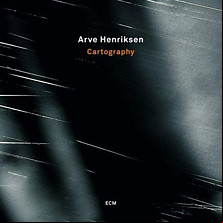BBC Review 1bj6o
A rich, moving work that rewards deep listening again and again.
Colin Buttimer 2008
If you're unfamiliar with the Norwegian trumpeter's solo work, you may have encountered him on one of the many projects he's contributed to including David Sylvian's Nine Horses, Supersilent, the Christian Wallumrød Ensemble or the first four Food records. His sound is unmistakable: breathy, imioned and alternately earthy and ethereal.
Cartography is Arve Henriksen's fourth album and his first for ECM, parent label to Rune Grammofon which released Sakuteiki, Chiaroscuro and Strjon. As a result of the move, there's no Kim Hiorthoy cover design to gladden the heart, instead there's a rather dreary rain-streaked abstraction. The image is appropriate, though, as Cartography is Henriksen's darkest work to date.
Each album has to a greater or lesser extent been thematic and Cartography portrays a sense of uncertainty and loss engendered by contemporary life. It's an existential Scandinavian blues, if you will. Arve's trumpet is set like flashes of illumination in a gathering, overwhelming night. His immensely lyrical approach makes this all the more poignant and mines territory first explored on Chiaroscuro. Given the beauty of Arve's tone, it's a tribute to his artistry that Cartography at no point falls prey to the merely picturesque or sentimental.
Sampler Jan Bang and Erik Honoré provide production duties and guests include percussionist Audun Klieve, guitarist Eivind Aarset, Trio Mediaeval and singer Anna Maria Friman. David Sylvian also contributes two sonorously enunciated spoken word pieces which project semi-autobiographical themes that conjure dystopian near futures, like the film, The Children Of Men.
Louis Armstrong, Miles Davis, Don Cherry and Jon Hassell redefined the sound of the trumpet. It may be possible to see Henriksen ing this lineage, even as he pays a stylistic debt to Hassell. With Cartography, he continues to experiment while delving deeper into the wellsprings of feeling and native culture that have nourished him in his work to date. Cartography is a rich, moving work that rewards deep listening again and again.




